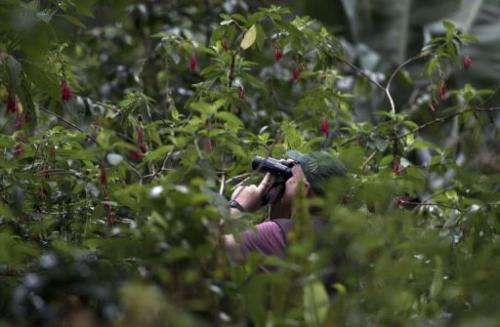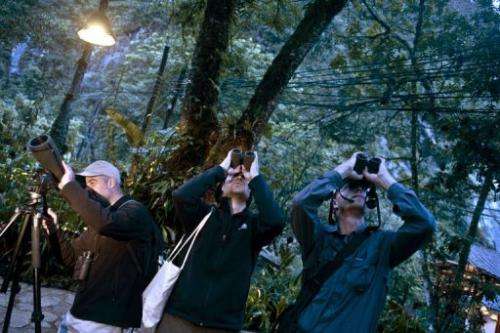Peru's winged wonders stir birders' competitive passions

Competitive birdwatching might sound like an oxymoron. Try telling that to ornithologists from around the world racing around Peru on a six-day marathon vying to become best birder.
"I am covered in bug bites, my legs are killing me and I got sick and threw up from the altitude," Ryan Terrill, 26, a member of the winning American team, told AFP.
"Despite all that, I have been able to see all the birds I have always wanted to see," added Terrill, all smiles.
Twenty-four seasoned bird specialists from Britain, South Africa, Brazil, Spain and the United States took part in "Birding Rally Challenge Peru."
Decked out in shorts and caps, binoculars and cameras around their necks, these guys could be mistaken for random outdoorsy tourists, maybe on their way to Macchu Picchu.
But they are super-specialists, indeed. Some competitors are among the world's best known and most respected authorities on bird life.
They are all up, before five in the morning, pushing through brush at the Tambopata nature reserve with the same goal: identifying the greatest number of birds possible, as the clock ticks down.
Off in the distance, a ball of scarlet feathers stands out against the verdant tropical jungle of the Amazon basin. It is the Andean cock-of-the-rock, or Rupicola Peruviana, a red, white and black mid-sized gem widely seen as Peru's national bird.

And the enthusiasm for seeing such rare and beautiful wildlife, for many of the experts, borders on obsession.
"Peru is one of the best places in the world for birdwatching in terms of biodiversity and infrastructure as well," said Jordi Sargatal, a Spanish expert who has authored several books on ornithology.
Sargatal's team, "Tramuntana Birding," came in last, but had fun anyway and said they would have to study more species before next year's event.
Terrell's team "Tigrisomas", made up of four doctoral students in ornithology at Louisiana State University in Baton Rouge, took the big feathered prize: covering the most terrain in six days while identifying a staggering 493 bird species.
This year the competition wrapped up at the foot of the famous Inca citadel Macchu Picchu, in the town of Aguas Calientes, in the southern region of Cusco.
"Normally, the birdwatching competition was done in just one day. But we really wanted to highlight Peru's biodiversity. It has 1,800 registered bird species including 117" unique to Peru, said contest coordinator Dennis Osorio.
"Just in the area around Macchu Picchu, there are 700 different bird species, many of them found nowhere else," Osorio said.

A lot of change has come from within Peru itself, said American Tom Schulenberg, who literally wrote the book on birding in Peru.
"What has changed so dramatically... is Peruvians' growing interest in their own environment," said Schulenberg, who has been visiting the South American nation of arid coastal, mountain and jungle terrains, for 35 years.
The rally's turn in the south, where relatively little birding is done, brought some surprises. One birder spied a "Black Swift Apodidae," a migratory bird that resembles a swallow but is native to North America.
Tourism Deputy Minister Claudia Cornejo presented the prize to the winners: a trophy shaped like—what else?—a black-faced Cotinga (Conioptilon mcilhennyi).
Cornejo says Peru aims to become the world's top birding tourism destination, which could earn it at least $50 million a year.
(c) 2012 AFP
















